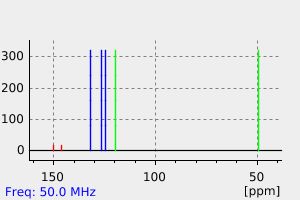N,N-diallyl-(4-nitrobenzene)sulfonylamine | 35735-57-0
中文名称
——
中文别名
——
英文名称
N,N-diallyl-(4-nitrobenzene)sulfonylamine
英文别名
N,N-diallyl-4-nitrobenzenesulfonamide;N,N-diallyl-p-nitrobenzenesulfonamide;N,N-Diallyl-p-nitrobenzolsulfonamid;N,N-diallyl 4-nitrobenzenesulfonamide;4-nitro-N,N-bis(prop-2-enyl)benzenesulfonamide
CAS
35735-57-0
化学式
C12H14N2O4S
mdl
MFCD01212726
分子量
282.32
InChiKey
VGAWPVVNQSRFSP-UHFFFAOYSA-N
BEILSTEIN
——
EINECS
——
-
物化性质
-
计算性质
-
ADMET
-
安全信息
-
SDS
-
制备方法与用途
-
上下游信息
-
文献信息
-
表征谱图
-
同类化合物
-
相关功能分类
-
相关结构分类
物化性质
-
熔点:61.2-61.9 °C
-
沸点:419.5±55.0 °C(Predicted)
-
密度:1.265±0.06 g/cm3(Predicted)
计算性质
-
辛醇/水分配系数(LogP):2.2
-
重原子数:19
-
可旋转键数:6
-
环数:1.0
-
sp3杂化的碳原子比例:0.17
-
拓扑面积:91.6
-
氢给体数:0
-
氢受体数:5
上下游信息
-
下游产品
中文名称 英文名称 CAS号 化学式 分子量 —— N,N-diallyl-4-aminobenzenesulfonamide 193891-96-2 C12H16N2O2S 252.337
反应信息
-
作为反应物:参考文献:名称:Potent and selective N-(4-sulfamoylphenyl)thiourea-based GPR55 agonists摘要:To date, many known G protein-coupled receptor 55 (GPR55) ligands are those identified among the cannabinoids. In order to further study the function of GPR55, new potent and selective ligands are needed. In this study, we utilized the screening results from PubChem bioassay AID 1961 which reports the results of Image-based HIS for Selective Agonists of GPR55. Three compounds, CID1792579, CID1252842 and CID1011163, were further evaluated and used as a starting point to create a series of nanomolar potency GPR55 agonists with N-(4-sulfamoylphenyl)thiourea scaffold. The GPR55 activity of the compounds were screened by using a commercial beta-arrestin PathHunter assay and the potential compounds were further evaluated by using a recombinant HEK cell line exhibiting GPR55-mediated effects on calcium signalling. The designed compounds were not active when tested against various endocannabinoid targets (CB1R, CB2R, FAAH, MGL, ABHD6 and ABHD12), indicating compounds' selectivity for the GPR55. Finally, structure activity relationships of these compounds were explored. (C) 2015 Elsevier Masson SAS. All rights reserved.DOI:10.1016/j.ejmech.2015.10.050
-
作为产物:参考文献:名称:机械化学钌催化的烯烃复分解摘要:我们描述了 Ru 催化的烯烃复分解的机械化学方法的发展,包括交叉复分解和闭环复分解。该方法使用市售催化剂以不使用或仅使用催化量的液体实现多克规模的固体或液体烯烃的高产率、快速、室温复分解。DOI:10.1021/jacs.5b00151
文献信息
-
Direct use of allylic alcohols in the allylation of sulfonylimidates作者:Ryosuke Matsubara、Koichiro Masuda、Jyunya Nakano、Shū KobayashiDOI:10.1039/c0cc03067h日期:——We have developed catalytic allylation reactions of sulfonylimidates using allylic alcohols as allylating reagents. Stoichiometric amounts of neither activators nor bases are required in this reaction.
-
Synthesis of N-Sulfonyl- and N-Acylpyrroles via a Ring-Closing Metathesis/Dehydrogenation Tandem Reaction作者:Weiqiang Chen、Yin-Lin Zhang、Hui-Jing Li、Xiang Nan、Ying Liu、Yan-Chao WuDOI:10.1055/s-0039-1690002日期:2019.10N-acylpyrroles were synthesized via olefin ring-closing metathesis of diallylamines and in situ oxidative aromatization in the presence of the ruthenium Grubbs catalyst and a suitable copper catalyst. In the presence of Cu(OTf)2 and CuBr2, the reaction afforded N-sulfonyl- and N-acylpyrroles, respectively, in one pot. Under an oxygen atmosphere, the reaction went smoothly without the need of hydroperoxide抽象的 N-磺酰基-和N-酰基吡咯是通过二烯丙基胺的烯烃闭环易位和在钌Grubbs催化剂和合适的铜催化剂的存在下原位氧化芳构化而合成的。在Cu(OTf)2和CuBr 2的存在下,反应在一锅中分别得到N-磺酰基-和N-酰基吡咯。在氧气气氛下,不需要氢过氧化物氧化剂即可使反应顺利进行。该方案具有许多优点,例如使用无害氧化剂和易于获得的起始原料,在一个锅中操作,并显示出广泛的底物范围。 N-磺酰基-和N-酰基吡咯是通过二烯丙基胺的烯烃闭环易位和在钌Grubbs催化剂和合适的铜催化剂的存在下原位氧化芳构化而合成的。在Cu(OTf)2和CuBr 2的存在下,反应在一锅中分别得到N-磺酰基-和N-酰基吡咯。在氧气气氛下,不需要氢过氧化物氧化剂即可使反应顺利进行。该方案具有许多优点,例如使用无害氧化剂和易于获得的起始原料,在一个锅中操作,并显示出广泛的底物范围。
-
Metal‐Catalyzed Organic Reactions by Resonant Acoustic Mixing**作者:Lori Gonnet、Cameron B. Lennox、Jean‐Louis Do、Ivani Malvestiti、Stefan G. Koenig、Karthik Nagapudi、Tomislav FriščićDOI:10.1002/anie.202115030日期:2022.3.21Resonant Acoustic Mixing (RAM) enables mechanochemical organic synthesis that avoids milling or crushing media, as well as bulk solvents. The RAM methodology enables significant simplification and improvement of mechanochemical olefin metathesis, the first mechanochemical strategy for ene-yne metathesis, and permits the direct, 200-fold scaling-up of the mechanochemical synthesis of pharmaceutically
-
Process for the production of oxabispidines申请人:Pavey John公开号:US06936712B1公开(公告)日:2005-08-30There is provided a process for the preparation of a compound of formula I, (I), or a pharmaceutically acceptable derivative thereof, wherein A, B, G, R 1 , R 2 , R 3 , R 4 and R 41 to R 46 have meanings given in the description, which process comprises the dehydrative cyclisaton of a compound of formula II, (II).
表征谱图
-
氢谱1HNMR
-
质谱MS
-
碳谱13CNMR
-
红外IR
-
拉曼Raman
-
峰位数据
-
峰位匹配
-
表征信息
同类化合物
(βS)-β-氨基-4-(4-羟基苯氧基)-3,5-二碘苯甲丙醇
(S,S)-邻甲苯基-DIPAMP
(S)-(-)-7'-〔4(S)-(苄基)恶唑-2-基]-7-二(3,5-二-叔丁基苯基)膦基-2,2',3,3'-四氢-1,1-螺二氢茚
(S)-盐酸沙丁胺醇
(S)-3-(叔丁基)-4-(2,6-二甲氧基苯基)-2,3-二氢苯并[d][1,3]氧磷杂环戊二烯
(S)-2,2'-双[双(3,5-三氟甲基苯基)膦基]-4,4',6,6'-四甲氧基联苯
(S)-1-[3,5-双(三氟甲基)苯基]-3-[1-(二甲基氨基)-3-甲基丁烷-2-基]硫脲
(R)富马酸托特罗定
(R)-(-)-盐酸尼古地平
(R)-(-)-4,12-双(二苯基膦基)[2.2]对环芳烷(1,5环辛二烯)铑(I)四氟硼酸盐
(R)-(+)-7-双(3,5-二叔丁基苯基)膦基7''-[((6-甲基吡啶-2-基甲基)氨基]-2,2'',3,3''-四氢-1,1''-螺双茚满
(R)-(+)-7-双(3,5-二叔丁基苯基)膦基7''-[(4-叔丁基吡啶-2-基甲基)氨基]-2,2'',3,3''-四氢-1,1''-螺双茚满
(R)-(+)-7-双(3,5-二叔丁基苯基)膦基7''-[(3-甲基吡啶-2-基甲基)氨基]-2,2'',3,3''-四氢-1,1''-螺双茚满
(R)-(+)-4,7-双(3,5-二-叔丁基苯基)膦基-7“-[(吡啶-2-基甲基)氨基]-2,2”,3,3'-四氢1,1'-螺二茚满
(R)-3-(叔丁基)-4-(2,6-二苯氧基苯基)-2,3-二氢苯并[d][1,3]氧杂磷杂环戊烯
(R)-2-[((二苯基膦基)甲基]吡咯烷
(R)-1-[3,5-双(三氟甲基)苯基]-3-[1-(二甲基氨基)-3-甲基丁烷-2-基]硫脲
(N-(4-甲氧基苯基)-N-甲基-3-(1-哌啶基)丙-2-烯酰胺)
(5-溴-2-羟基苯基)-4-氯苯甲酮
(5-溴-2-氯苯基)(4-羟基苯基)甲酮
(5-氧代-3-苯基-2,5-二氢-1,2,3,4-oxatriazol-3-鎓)
(4S,5R)-4-甲基-5-苯基-1,2,3-氧代噻唑烷-2,2-二氧化物-3-羧酸叔丁酯
(4S,4''S)-2,2''-亚环戊基双[4,5-二氢-4-(苯甲基)恶唑]
(4-溴苯基)-[2-氟-4-[6-[甲基(丙-2-烯基)氨基]己氧基]苯基]甲酮
(4-丁氧基苯甲基)三苯基溴化磷
(3aR,8aR)-(-)-4,4,8,8-四(3,5-二甲基苯基)四氢-2,2-二甲基-6-苯基-1,3-二氧戊环[4,5-e]二恶唑磷
(3aR,6aS)-5-氧代六氢环戊基[c]吡咯-2(1H)-羧酸酯
(2Z)-3-[[(4-氯苯基)氨基]-2-氰基丙烯酸乙酯
(2S,3S,5S)-5-(叔丁氧基甲酰氨基)-2-(N-5-噻唑基-甲氧羰基)氨基-1,6-二苯基-3-羟基己烷
(2S,2''S,3S,3''S)-3,3''-二叔丁基-4,4''-双(2,6-二甲氧基苯基)-2,2'',3,3''-四氢-2,2''-联苯并[d][1,3]氧杂磷杂戊环
(2S)-(-)-2-{[[[[3,5-双(氟代甲基)苯基]氨基]硫代甲基]氨基}-N-(二苯基甲基)-N,3,3-三甲基丁酰胺
(2S)-2-[[[[[((1S,2S)-2-氨基环己基]氨基]硫代甲基]氨基]-N-(二苯甲基)-N,3,3-三甲基丁酰胺
(2S)-2-[[[[[[((1R,2R)-2-氨基环己基]氨基]硫代甲基]氨基]-N-(二苯甲基)-N,3,3-三甲基丁酰胺
(2-硝基苯基)磷酸三酰胺
(2,6-二氯苯基)乙酰氯
(2,3-二甲氧基-5-甲基苯基)硼酸
(1S,2S,3S,5S)-5-叠氮基-3-(苯基甲氧基)-2-[(苯基甲氧基)甲基]环戊醇
(1S,2S,3R,5R)-2-(苄氧基)甲基-6-氧杂双环[3.1.0]己-3-醇
(1-(4-氟苯基)环丙基)甲胺盐酸盐
(1-(3-溴苯基)环丁基)甲胺盐酸盐
(1-(2-氯苯基)环丁基)甲胺盐酸盐
(1-(2-氟苯基)环丙基)甲胺盐酸盐
(1-(2,6-二氟苯基)环丙基)甲胺盐酸盐
(-)-去甲基西布曲明
龙蒿油
龙胆酸钠
龙胆酸叔丁酯
龙胆酸
龙胆紫-d6
龙胆紫







